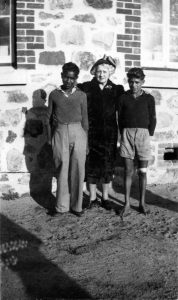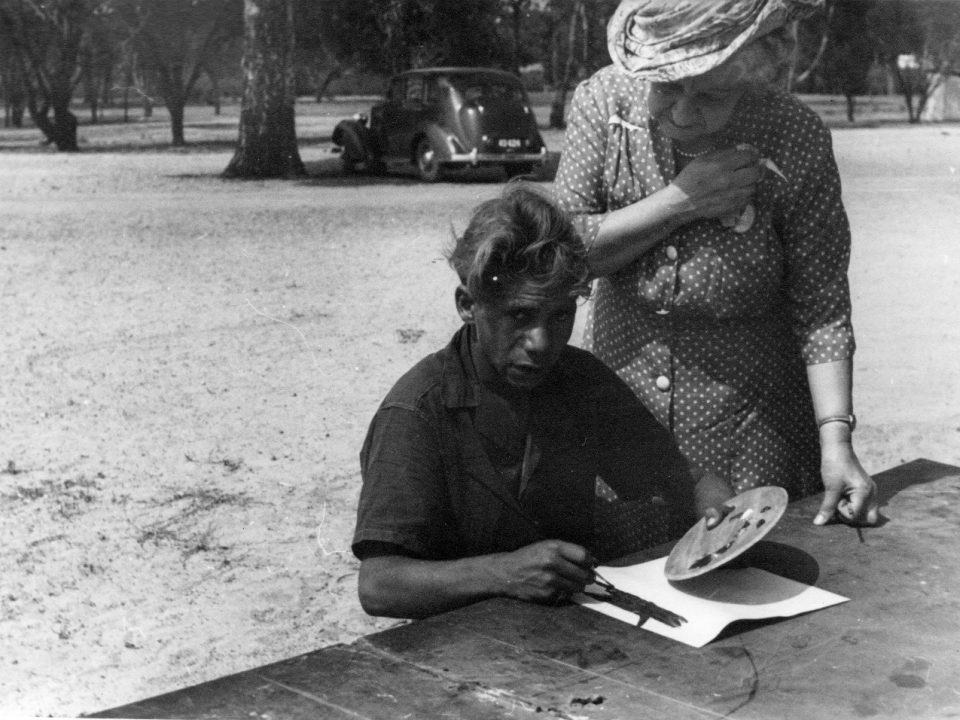Seventy-three years ago yesterday, 71-year old Englishwoman Mrs Florence Rutter and her friend Vera Hack arrived for a two and a half day visit of Carrolup Native Settlement. This visit was not only special in its own right, but it triggered a series of important events that still resonate today.
Mrs Rutter, who was Founder President of the Central London Soroptimist Club, was visiting Australia in 1949 to see the state of the Soroptimist Movement in Australia and set up new Soroptimist clubs.

Mrs Rutter with Reynold Hart (Left) and Parnell Dempster (Right). Photographer: Noel White, 31st July, 1949. Noel & Lily White Collection.
Whilst in Perth, Florence read an article by Muriel Wieck in the magazine Milady that publicised the Carrolup Native Settlement and reproduced some of the boys’ art. She was so thrilled by the beauty of the drawings that she decided to visit Carrolup, not only to meet some Aboriginal children, but to buy some of their work if available.
Florence visited the native settlement on Sunday, 31 July 1949, and met Noel and Lily White and some of the children, including two of the main child artists, Reynold Hart and Parnell Dempster. She purchased a collection of the children’s artworks, which she then showcased to great public acclaim in seven cities around Australia and New Zealand. She later decided to return to Carrolup, this time with a close friend. Here is what I wrote in my eBook Connection: Aboriginal Child Artists Captivate Europe:
‘Florence and Vera receive a rousing welcome from the boys when they arrive on the morning of the 31st of January. The ladies joyfully distribute chocolate, which is well-received. Florence tells the boys how well their work has been received around Australia and New Zealand. She shows them photographs of people admiring their work when hung in exhibition in the various cities.
“When Mr. White asked me to talk to the boys, every child gave me his undivided attention, listened in an interested fashion, and looked at me with real gratitude when I related how their pictures had been shown and how much the public had appreciated their work. I spoke to them for half an hour – there was so much to tell them! At the end when Mr White suggested they would like to thank me, they rose from their seats, gave me three cheers, and very grateful, happy smiles. No class of boys in any school could have shown more appreciation….” Florence Rutter, Personal Diary, 1st February 1950
Mrs Rutter asks the boys to come up to the table and choose a gift of pastels, paints or crayons. She notes that “not one boy grabbed for the biggest or the best. Each one stood smiling, but did not attempt to chose anything until invited to take what he preferred.” [Emphasis in original]
In the afternoon, Noel asks the boys in the classroom if they would each do a picture for their visitors to show them working with their new paints and crayons. Florence could then take some of them back to her family and friends in England.
On the second day of their visit (1st February 1950), Mrs Hack takes a number of other photographs (and a 16mm movie) of Mrs Rutter and the boys. Afterwards, the older boys, six of whom Mrs Rutter describes as very good artists, do a drawing with their new pastels, which are presented to the visitors. Each boy signs his name and age on his drawing. I continue from my book:

The boys of Carrolup marching for Mrs Rutter and Mrs Hack. Cliff Ryder is the third boy from the front of the nearest line. Photographer: Vera Hack, January 1950. Noel & Lily White Collection.
‘Mrs Rutter asks Mr White if he would allow her to show Parnell Dempster how to use oil paints, if he wants to learn. Both Mr White and Parnell are eager to try this experiment. A thumb hole is cut in an oval piece of wood for a palette, whilst a little tin is used for cleaning brushes. Mrs Rutter provides just a few colours, as oil paints are scarce and expensive in Australia.
“… I was very curious to see how this boy of 14 who uses water colours or pastels equally well, would manage with oil paints. It was remarkable how soon it was that he could mix colours and adopt the different way of handling the brushes. He got to work on a small picture after a few strokes.” Florence Rutter, Personal Diary, 1st February 1950
In around two and a half hours, Parnell completes his first oil painting—quite possibly the first oil painting by an Australian Aboriginal person. The experience is quite a thrill for all there, and Mrs Hack photographs Parnell with his masterpiece. Parnell offers the painting to Mrs Rutter, but she points out to him that this first oil painting he has done must belong to him or his school. She asks him if will do a small picture for her in the future….
… After they return to the hotel in the evenings, the two women sort out and cover with cellophane all the pictures that are to be dispatched for the orders from around Australia and New Zealand, and others (over a hundred) that will return with Mrs Rutter to Europe.’ ©Aboriginal Child Artists of Carrolup by David Clark, in association with John Stanton
I’ll continue relating the story of this visit tomorrow.
[1] Soroptimist Clubs are complementary to the Rotary Clubs for men, and the first one was founded in California in 1921. The motto of the organisation is ‘Hold the Right Thought’—in other words, ‘Think Positively’.


